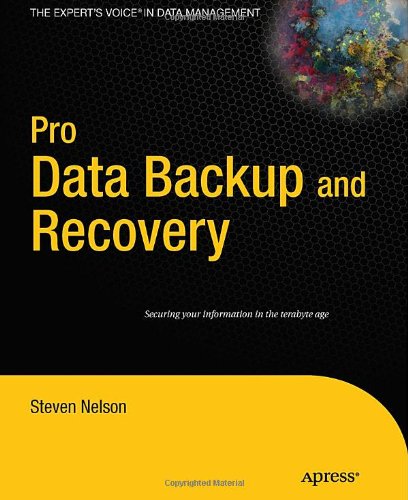

Most ebook files are in PDF format, so you can easily read them using various software such as Foxit Reader or directly on the Google Chrome browser.
Some ebook files are released by publishers in other formats such as .awz, .mobi, .epub, .fb2, etc. You may need to install specific software to read these formats on mobile/PC, such as Calibre.
Please read the tutorial at this link: https://ebookbell.com/faq
We offer FREE conversion to the popular formats you request; however, this may take some time. Therefore, right after payment, please email us, and we will try to provide the service as quickly as possible.
For some exceptional file formats or broken links (if any), please refrain from opening any disputes. Instead, email us first, and we will try to assist within a maximum of 6 hours.
EbookBell Team

4.1
80 reviews
ISBN 10: 1430226625
ISBN 13: 9781430226628
Author: Steven Nelson
Good backup and recovery strategies are key to the health of any organization. Medium- to very-large-scale systems administrators have to protect large amounts of critical data as well as design backup solutions that are scalable and optimized to meet changing conditions. Pro Data Backup and Recovery will cover some of the more common backup applications, such as Symantec NetBackup/BackupExec, EMC NetWorker, and CommVault, but the main discussion will focus on the implementation of 21st century architectures that allow the backup software to be a “commodity” item. The underlying architecture provides the framework for meeting the requirements of data protection for the organization. This book covers new developments in data protection as well as the impact of single-instance storage upon backup infrastructures. It discusses the impact of backup and data replication, the often misapplied B2D and D2D strategies, and “tapeless” backup environments. Continuous data protection and remote replication strategies are also addressed as they are integrated within backup strategies—a very important topic today. Learn backup solution design regardless of specific backup software Design realistic recovery solutions Take into account new data protection standards and the impact of data replication Whether you are using NetBackup, CommVault, or some other backup software, Pro Data Backup and Recovery will give you the information you need to keep your data safe and available.
CHAPTER 1 Introduction to Backup and Recovery
Who Should Read this Book?
Backup and Recovery Concepts
Backups
Archives
Service and Recovery Objectives: Definitions
Summary
CHAPTER 2 Backup Software
Software: CommVault Simpana
History and Background
Terminology
Clients
CommVault CommServer
MediaAgents
Symantec NetBackup
History and Background
NetBackup Master Servers
Media Servers
Clients
Data Flow within the NetBackup Environments
Summary
CHAPTER 3 Physical Backup Media
Tape
Digital Linear Tape (DLT)
Linear Tape Open (LTO)
Sun/StorageTek T1 0000 (T10k)
Tape Storage Characteristics
Disk
RAID 10
RAID 5
RAID 6
RAID Implementation and Disk Performance
Network Attached Storage (NAS)
Summary
CHAPTER 4 Virtual Backup Media
Virtual Tape Libraries
VTL Types
Virtual Tape Allocation Models
Why VTL?
Replication
Other Virtualized Media and a Look Ahead
CHAPTER 5 New Media Technologies
Deduplication
Fixed-Block Deduplication
Variable-Block Deduplication
Data Type Limitations: Media, Mystery, and Mother Nature
Deduplication Types and Terms
Source-Based Deduplication
Target-Based Deduplication
NetBackup
CommVault
Continuous Data Protection/Remote Replication
Cloud Storage
Summary
CHAPTER 6 Software Architectures-CommVault
General Configuration
Disk and MagLib types
Disk Writers
Multiplexing
Fill/Spill versus Spill/Fill
Storage Policies
Data Interface Pairs
CommCell with Single Target
CommCell with Single MediaAgent
Advanced Storage Connectivity
CommCell with Multiple MediaAgents
Network Resources
Storage Resources
Multiple CommCells
Summary
CHAPTER 7 Software Architectures- NetBackup
General Configuration
Multiplexing/Multistreaming
Inline Deduplication (Twinning)
Buffer Tuning Parameters
SIZE_DATA_BUFFERS/NUMBER_DATA_BUFFERS
NET_BUFFER_SZ
Creating Secondary Copies (Vault/bpduplicate)
Generic Configurations
NetBackup Master with a Single Target
NetBackup Master with a Single Media Server
Storage Units
Storage Unit Media Selection
Advanced Storage Unit Media types
NAS Storage
SAN Storage
NetBackup Master with multiple Media Servers
Network Resources
Network Interface Teaming
When Do You Add a Media Server?
Storage Resources
Microsoft Windows Storage Features
Ensure Proper Storage Configuration
Use Multiple Paths to Storage
Multiple Storage Domains
Summary
CHAPTER 8 Application Backup Strategies
General Strategies
File Systems
Normal File Systems
Selective Backup
Backups Split By Schedule
High Density File Systems (HDFSs)
Block-level Backups
Source-Based Deduplication
File Systems Summary
Databases
Database log Backups
locally Controlled Database Backups
Pre- and Post-Scripts
Snapshot Backups
Snapshots
Split Mirror
SQl Server
SQL Server Terminology
SQL Lightspeed
Oracle
Oracle Terminology
Oracle Hot Backup
RMAN Backups
Mail Servers
Exchange
lotus Notes
Other Applications
Virtual Machines
Deduplication and VM Backups
Summary
CHAPTER 9 Putting It All Together: Sample Backup Environments
Cloud/Backup as a Service
Security and BaaS
BaaS Costs
Single Backup Servers
Selection of Backup Targets
Performance Considerations
Dealing with Growth
Client Performance Considerations
General Application Performance Considerations
Database Backup Performance
Single Server/Single Media Writer
CommVault MediaAgent Approach
Using Disk for Staging Backups
Single Master/Multiple Media Writer
Deduplication in Multiple Media Writer Environments
Application Backup Considerations
Deduplication: When and Where?
Target Deduplication
Source Deduplication
Deduplication for Virtual Machines (VMs)
Remote Office (RO) Deployments
Remote Office (RO)
Regional Site (RS)
Regional Datacenter (RDC)
Wide Area Network (WAN) Connection Considerations
Adding a Second Datazone in the RDC
DR Potential of RDCs
NetBackup DR
CommVault DR
Using Deduplication for DR
Remote Office Wrap-Up
Long-Distance Backups
Transnational Backups
Summary
CHAPTER 10 Monitoring and Reporting
Backup Software
Success/Failure
Failure Codes
Client Backup Speed
Amount of Data Protected
Count of Current Tape Media
Disk Storage Capacity
Location of Last Catalog Backup
Backup Servers
CPU Utilization
Memory Utilization
Network Utilization
Backup Media Utilization
Optional Elements
Client Performance
CPU/RAM Utilization
I/O Utilization
Client Network Utilization
Network Performance
SAN/Disk Performance
Disk Idle Percentage
Bytes Moved Per Time
Disk Queue Depth
Deduplication Ratios
Summary
CHAPTER 11 Summary
Good Backup Is Important!
Defending Costs
One Size Does Not Fit All
lndex
pro data backup and recovery pdf
data backup and recovery policy
data backup and recovery strategies
data backup and recovery near me
prosoft data backup
Tags: Steven Nelson, Backup, Recovery